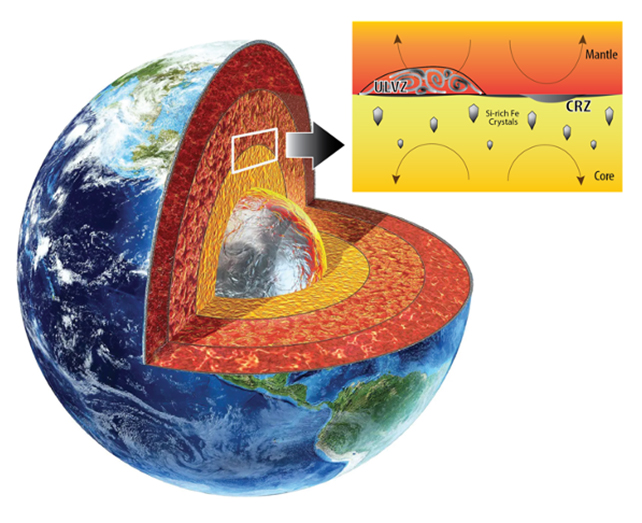Products You May Like
By listening to the echo of earthquakes bouncing about inside our planet, we can make a good guess at what’s inside Earth without slicing it up. Unfortunately seismic waves often have inconsistencies that scientists are yet to fully understand.
One source of variability occurs in low-density pockets of material some 3,000 kilometers (just under 1,900 miles) below the surface, between the liquid iron alloy outer core and the mantle.
A new study proposes a silicon-rich ‘snow’ that rises from the outer core could help explain some of the anomalies in observations. Since silicon would make the particles lighter than the surrounding liquid iron, the material could flow out towards the mantle and settle in drifts that cause sound waves to distort in unpredictable ways.

“If silicon and hydrogen are the two main light elements in the outermost core with appropriate abundances, such a rising silicon-rich snow can occur,” says geoscientist Suyu Fu from the University of Tokyo in Japan.
To test this, the team recreated conditions inside Earth’s outer core in a laboratory. An iron-silicon alloy was loaded inside a hydrogen-argon gas before being ultra-compressed inside a diamond anvil cell.
These devices are often used by geologists to achieve levels of compression comparable to those inside planets like our own. Samples are compressed via mechanical force between two diamonds (hence the name) and studied for changes.
In this case the sample was heated using lasers and monitored via X-rays. The scientists were able to overcome a problem with previous experiments where high temperatures would cause the hydrogen containing the iron alloy to diffuse into the diamond.
“Our team developed a new method where hydrogen is mixed with argon in diamond anvil cells,” says geoscientist Sang-Heon Dan Shim, from Arizona State University.
“Argon does not react with the sample but suppresses hydrogen diffusion into diamond anvils, enabling us to achieve the extreme conditions in the laboratory.”
Under these similar pressure and temperature conditions to Earth’s outer core, the researchers found that silicon-rich crystallites ‘snow’ could form and rise through the denser liquid iron to accumulate at the border of the mantle and the outer core, possibly causing some of the anomalies noticed by scientists as they scan the deepest parts of the planet.
While you may think that none of this matters too much to us up on Earth’s surface, the movement of the outer core drives our planet’s magnetic field, which in turn protects us against the wearing effects of outer space and solar weather.
Gaining a better understanding of what’s in the outer core, how it’s moving, and how that might affect its interaction with the mantle, is crucial in predicting how Earth’s magnetic field might continue to operate in the future.
“The silicon-rich alloy crystallization was found during our experiments in snowy winter days at Chicago during the pandemic,” says Shim.
“It is interesting that such crystallization behavior can lead to rising silicon-rich snow in the outer core.”
The research has been published in Nature.
